WEEK 4
EXPLORING THE POSIBILITIES
VISUALLY IMAPIRED CHILDREN AS THE TARGET AUDIENCE
Rather than focusing solely on specific visual impairments as previously, I chose to narrow the age demographic instead. This decision stemmed from the extensive amount of existing studies on visually impaired adults, while leaving ample room for exploration within the demographic of children. Choosing visually impaired children as the new target audience seemed valuable as studies have indicated that VI children also face challenges in developing spatial awareness, which decreases their freedom to travel independently—a human right every child has.



FAIRY TALES AS A WAY TO PROBLEM-SOLVE
Through research, I have found out that fairy tales can help children learn how to navigate life. They
learn from the characters in stories, even as adults. These fairy tales help them as they connect to
their own lives, dreams, and anxieties, and consider what they would do in their shoes.
Fairy tales bring adventure, magic, and imagination to young children—a great recipe for learning
through play. Children become fascinated with make-believe, their innocence allows them to believe in
every possibility whilst creating and engaging in play with their peers and teachers.
“In many fairy tales, children not only conquer opponents, but also become kings and queens by virtue of their good hearts and brave deeds. They are active agents in their own destiny as they strive to become their best selves.”
Can I utilise this information to immerse children in an adventure to make them learn through play?
NEW THEMES FOR DISSERTATION
As my project has taken a new direction, not everything in my dissertation is relevant anymore. Specifically, I have shifted away from focusing on web accessibility and interface design. Here are the themes I am currently thinking of including:
-

Development of cognitive maps for spatial navigation:
This section of the literature review will mention what cognitive mapping is, why it is important and its relation to someone with a visual impairment.
-

Tactile sensing and multisensory practice:
This section will introduce the practice of using multisensory elements, leveraging existing tactile maps with interactivity, and how to incorporate play into tactile sensing.
-

The concept of accessibility, usability, utility and compatibility:
This section will briefly mention the importance of including disabled individuals into ICT and HCI and the overall importance of accessibility, usability, utility and compatibility.
-

Emotional connection through fairy tales:
This section will talk about how fairy tales can be used as a tool to connect with children and make the outcome suitable for them.

WEEK 4 ROUNDTABLE

I attended this week’s roundtable discussion to seek advice from Vikas and Yasser regarding my new design concept. I approached the session with one specific question in mind: Should I conduct user testing with VI children, or would it be sufficient to base the design considerations solely on existing literature?
Feedback during The Roundtable
-

1.
Since this is a school project, it is okay to use literature to support my experiments, but if possible, I should do user testing on peers and friends.
-

2.
Developing a user persona can be crucial in shaping the design process, ensuring it remains focused and user-centred.
-

3.
To make an engaging and educational opportunity, I can consider looking into board games.
-

4.
For the map, I can abstract the world into a generic town.
-

5.
Define the project’s purpose to help establish a clear objective of the project. How will it work? What is it for? Will a parent help the child in using the tool?
-

6.
Explore various archetypes, in which I can draw inspiration from popular products like Duplo and Legos.
-

7.
Investigate methods to assess neighbourhood safety and base on which archetypes to include in the project.


WEEKLY ROUNDUP
I am feeling optimistic about this new concept. Unlike my previous idea from last semester, this one feels more fresh as I delve into unconventional areas that are not typically considered in design, especially compared to the projects I have done the previous two years at Lasalle. While I enjoy making publications and posters, exploring typography and design principles, and visual design in general, I have recently developed a keen interest in making physical products, something surprising since I have always gravitated towards digital design. I also see this as an opportunity to showcase my abilities as a designer and highlight my creativity in articulating and executing my own ideas and concepts.





